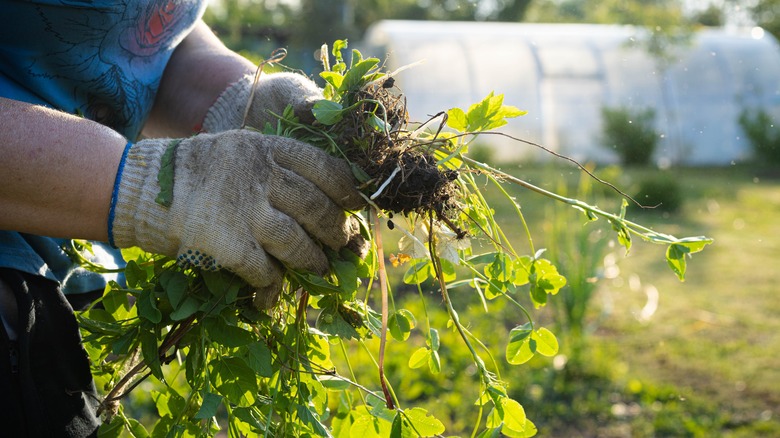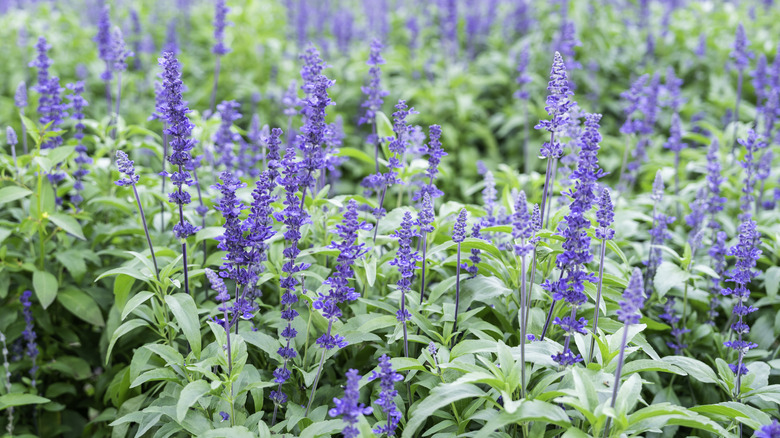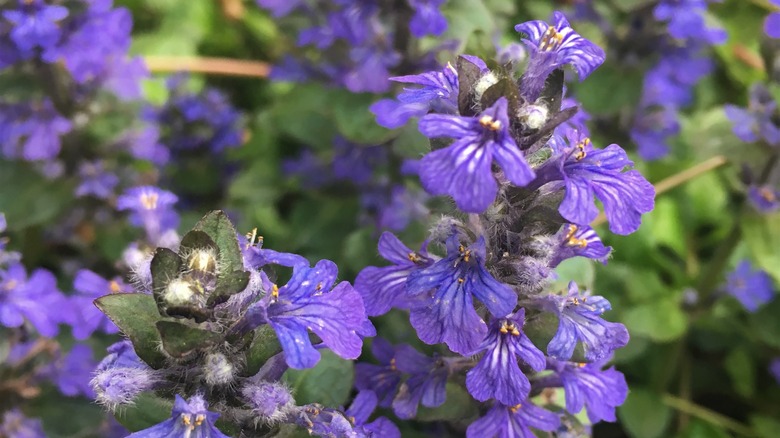The Fragrant Plant That Can Help Stop Weeds From Taking Over Your Garden
You'd be hard-pressed to find a gardener who loves dealing with weeds. When they keep coming back despite your best efforts to eliminate them, it may be time to grow a ground cover. Ground covers allow gardeners to get the best of both worlds because not only do they effectively suppress weed growth, but they further beautify a garden by adding tantalizing aromas, dimensional textures, and vibrant colors. While there are many ground covers to consider, sage is one that shouldn't be overlooked.
Sage, also called salvia officinalis, is a fragrant shrub that comes from the mint family. The shrub's growth habit makes it easy for the plant to crowd out weeds. Adding to its appeal are the plant's showy, lavender-blue blooms. Sage also makes for a pollinator-friendly companion plant, which is all the more reason to grow it. Beware that plants related to mint can be invasive. It's helpful to do prior research to ensure that the type of sage you grow won't be a fast-spreading invasive ground cover. If you need some ideas, however, lyreleaf sage and creeping sage are two varieties to look into.
Why you should grow sage as a ground cover
Sage possesses a few qualities that make it a delightful choice to grow as a ground cover. For one, the plant's sprawling growth habit allows it to cover large areas. Additionally, the shrub's bushiness ensures it grows densely, leaving little to no room for weeds to take up residence wherever it's planted.
Imagine, now that you have this sprawling perennial blanketing your garden space with no weeds in sight, the greenish-gray foliage blossoms to life with gorgeous blooms. Sage grows best in zones four to eight and in late spring, you can witness its floral abundance for yourself. Sage flowers appear in June, presenting with lavender-toned whorls that are one inch tall. Rather than glare at your garden as it fills with weeds, you can admire the blooming bounty and weed-fighting prowess that sage has to offer.
Best of all, sage makes for a great companion plant, perfect to be intermixed into your vegetable or herb gardens. Rosemary and oregano are herbs you'll want to plant next to sage. The sprawling plant also grows well among cabbage, carrots, and brassicas. Plus, sage flowers attract beneficial insects. With sage in your garden, your plants will thrive and your weeds will be things of the past.
Cultivars of sage that will make the best ground cover
Because sage comes from a wide genus with many varieties of the plant, some may be better at growing as a ground cover than others. To help you narrow down which ones to consider to keep weeds at bay, keep the following cultivars of sage at the top of mind. Lyreleaf sage is one cultivar that comes highly recommended as a ground cover. The plant functions like grass because it can be walked on and mowed down. It's also evergreen so it will provide color even when its blooms aren't around. Just be sure to water it regularly, so it can form a solid cover.
Salvia sonomensis, or creeping sage, is another good option. Though it can be temperamental, the plant grows purple-hued flowers that will add gorgeous color to your yard. Creeping sage can spread up to 10 feet across, making it ideal for suppressing weeds in a vast area. Unlike lyreleaf sage, creeping sage prefers minimal watering.


